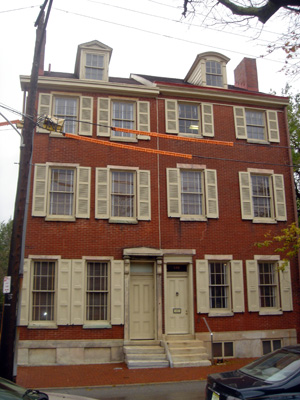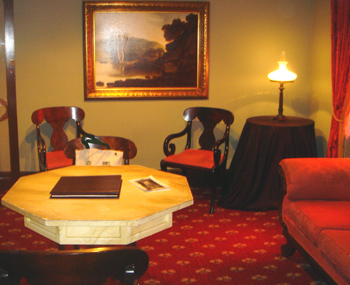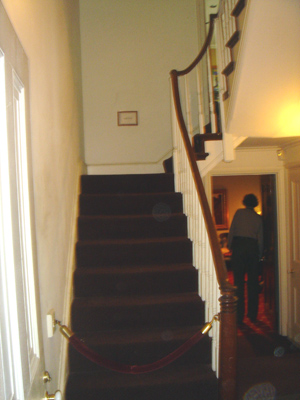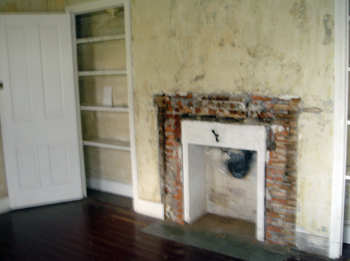
Poe house offers glimpse into author’s life
PHILADELPHIA– The wonders of Independence National Historical Park go beyond Independence Hall and the Liberty Bell.
Several blocks from the hustle and bustle of Independence Mall sits the Edgar Allan Poe National Historic Site and its literary charm.
“I like working the Poe House because it is a historic house with the theme of American literature,” park ranger Mike Jolly said. “You still learn the history here, plus Poe’s literary work.”
This house was Poe’s Philadelphia home between 1842 and 1844. After this time, the house was rented to multiple tenants until it became a unit of the National Park Service in 1978. The Poe House then opened for visitors in 1980.
| The house where author Edgar Allan Poe lived in the 1840s while working as an editor and writer in Philadelphia (Photos by Sarah Oline). |  |
Poe, known best for his dark poetry, was most successful during the years he inhabited this home.
The house today is open to visitors and includes a self-guided or park ranger-led tour, a video on Poe’s life and works, a reading room, a small gift shop, and seemingly endless information on Poe.
“The Poe House staff is a combination of Independence Hall park rangers and old-timers who worked there before it became a part of the park,” Missy Hogan, chief of Operations for Interpretations and Visitor Services, said. “They all know the house and his story.”
The current structure is actually a park service interpretation of Poe’s original home and what would have been his neighbor’s house. His neighbor’s home as been remodeled into a front room Visitor Center filled with information on and pictures of Poe and the site’s small gift shop, the reading room, and a small screening room for the Poe video.
“Poe’s side is much of the original housing,” Beverly Morris, volunteer coordinator of Independence National Park, said. “Those are the rooms they slept in and the floors they walked on.”
All rooms are completely empty because the building was leased after Poe lived there and the National Park Service decided to leave the rooms empty rather than guess what may have been in them.
“When I first heard there was nothing in the house, I was a little disappointed,” visitor Sobina Hollis said. “But after being here, I’m glad it’s this way. Poe is an icon for spooky tales and it allows you to use your imagination more.”
Visitors can choose to tour the house on their own or with the interpretations of one of the park rangers. If you would like a guided tour, it is better to make a reservation ahead of time. If you prefer to do the tour alone, the rangers will give you a map of the house with descriptions of what they conclude each room was used for.
| The Reading Room in the Visitor Center (Photo by Sarah Oline). |  |
Either way, a tour generally starts of with an eight-minute movie explaining Poe’s life, family and literary work.
The tour of the house includes three floors and the basement. The first floor is what would have been the parlor and kitchen.
The second floor was a small sitting room and Poe’s room. While the third floor housed a room for his young wife and cousin, Virginia, and one for his mother-in-law and aunt, Muddy. (Yes, Poe married his cousin.)
“Virginia was very sick and Poe had his own room so he wouldn’t disturb her while he worked,” said Park Ranger Stephen Medeiros.
“Going through the rooms was very evocative,” Hollis said. “You feel close to the past and the history.”
The rooms all have white walls, brick fireplaces, and closets. The stairs are very steep and narrow. Be careful while walking to the different levels. There is no lighting in the rooms other than the sun through the windows.
“It’s important for people to understand what life was like before modern conveniences,” Hollis said.
The most Poe-like part of the house is arguably the basement.
“This may look like a normal cellar, but it’s a little different knowing it is Poe’s,” said Medeiros.
The basement is indeed very dark and dreary with low ceilings (you may have to duck if you are taller than five feet nine inches) and small windows. Though visitors now enter from a remodeled staircase outside the original cellar, the small staircase Poe would have used is still intact. The rest of the basement is a collection of shelves and one fireplace.
“Supposedly a body can fit in that fireplace,” Medeiros suggested. “We haven’t tried.”
 “The tour of the house is really great, especially the basement,” Hogan said. “The description of a basement in Poe’s poem, ‘The Black Cat,’ is eerily similar to this one.”
“The tour of the house is really great, especially the basement,” Hogan said. “The description of a basement in Poe’s poem, ‘The Black Cat,’ is eerily similar to this one.”
“The basement was pretty creepy,” visitor Sue Vizoskie said. “Very atmospheric.”
After escaping the chill of the cellar, visitors can head over to the brightly decorated reading room in Poe’s neighbor’s home. The warm room is filled with red furniture and red-tinted windows.
“We don’t know how Poe furnished his home so the reading room is decorated according to his poem, ‘The Philosophy of Furniture,’ published in 1840,” park ranger Helen McKenna-Uff explained.
The reading room also has Poe’s complete collection of works for visitors to enjoy. There is also a collection of recorded Poe poetry and a stereo system.
“I think it’s very important to listen to Poe’s words in Poe’s home,” McKenna-Uff said.
McKenna-Uff, who actually plays Poe for special events, often does her own dramatization of Poe’s works for visitors. She is quite good at a scene from his novel, Tell Tale Heart, in which she attempts to prove the character’s sanity, despite the fact that he is, rather insanely, justifying a murder.
“I enjoyed the guide’s dramatization and reading,” said visitor Mary Ann Ferry.
If you have time, this is perhaps why it is better to take a ranger-led tour of the house.
“The rangers make the stories happen,” Hogan explained. “Even if the place doesn’t reflect the history exactly, the staff has the ability to bring it all together.”
“There is a lot of personality and less commonality in the tours,” Hollis said. “The guides are not reciting a learned piece which is more reassuring as an audience member.”
 The Poe House also holds many special events based on the time of year.
The Poe House also holds many special events based on the time of year.
Due to the spooky nature of Poe’s work, Halloween is a popular time to visit.
There are candlelight tours of the house throughout October, as it is also the anniversary month of Poe’s death.
“We try to work within broader themes in the country,” Hogan said. “For example, we do special programs for Poetry Month in April and programs focusing on Poe’s wife during Women’s History Month in March. They keep it to a literary circle.”
“I learned a lot about the less known aspects of Poe,” Vizoskie said. “I didn’t realize how much work he published.”
Whether you are interested in history, literature, or just looking for something to do in the historic city of Philadelphia, the Poe House is a quick, interesting, and slightly spooky way to add to your day.
If You Go
- Open: Wednesday – Sunday, 9 a.m. to 5 p.m. Closures: Mondays and Tuesdays; Veterans Day, Thanksgiving, Christmas and New Year’s Day
- Admission: Free
- Location: 532 N. 7th St., Philadelphia (7th and Spring Gardens Streets)
- Facilities: Restrooms, reading room, and souvenirs
- For tour information: 215-597-8780, Web site: http://www.nps.gov/edal/

Comments are Closed